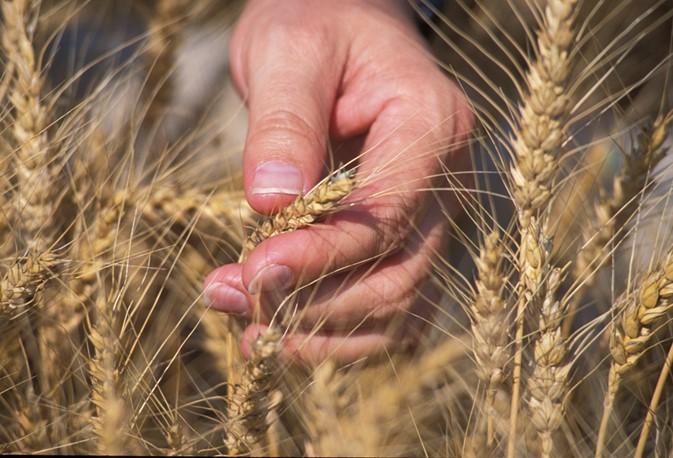Wheat Yields & Double-Crops—Time is Everything for Maximum Yields
Combines will be rolling very soon to harvest wheat, soon followed by the planter to get double-crop soybeans in the ground. As you know, for both wheat and soybeans, time is of the essence to maximize yields. This article is intended to be a reminder of how important timely harvest and rapid planting are for a double-crop system.
For wheat, there is a growing body of data pointing to the importance of the timely harvest. While wheat needs to be at about 12% moisture for storage, waiting to field-dry and harvest wheat at 12-14% will likely cost you a considerable loss in yield due to reduced test weight. Several studies in the Mid-Atlantic region over the past few years demonstrate that harvesting wheat at 18-20% moisture can maximize yields; and for every day after 18% moisture, wheat yields decrease approximately 0.5-2.5%. Furthermore, research shows that if wheat experiences cycles of wetting and drying prior to harvest, vomitoxin levels in the grain can increase by nearly 1 ppm. This is more reason to harvest around 18-20% moisture, especially if you observe head blight symptoms in your fields. Of course, harvesting wheat at 18-20% does require you to have the ability to immediately dry the grain to 12% or have a buyer willing to take high-moisture wheat and dry it (hopefully for a reasonable cost).
The second piece to the double-crop system is getting the soybeans in the ground as soon as possible. This can be tricky, especially if you are baling the straw. Ideally, the planters should be running the combines out of the field. For every day planting is delayed after mid-June, soybean yields decrease by roughly 1/2 bushel per day; and for every day after the end of June, expect about a 1-2 bushel per acre yield loss per day.
This article appears on June 2021, Volume 12, Issue 3 of the Agronomy news.
 English
English العربية
العربية Български
Български 简体中文
简体中文 繁體中文
繁體中文 Hrvatski
Hrvatski Čeština
Čeština Dansk
Dansk Nederlands
Nederlands Suomi
Suomi Français
Français Deutsch
Deutsch Ελληνικά
Ελληνικά हिन्दी
हिन्दी Italiano
Italiano 日本語
日本語 한국어
한국어 Norsk bokmål
Norsk bokmål Polski
Polski Português
Português Română
Română Русский
Русский Español
Español Svenska
Svenska Català
Català Filipino
Filipino עִבְרִית
עִבְרִית Bahasa Indonesia
Bahasa Indonesia Latviešu valoda
Latviešu valoda Lietuvių kalba
Lietuvių kalba Српски језик
Српски језик Slovenčina
Slovenčina Slovenščina
Slovenščina Українська
Українська Tiếng Việt
Tiếng Việt Shqip
Shqip Eesti
Eesti Galego
Galego Magyar
Magyar Maltese
Maltese ไทย
ไทย Türkçe
Türkçe فارسی
فارسی Afrikaans
Afrikaans Bahasa Melayu
Bahasa Melayu Kiswahili
Kiswahili Gaeilge
Gaeilge Cymraeg
Cymraeg Беларуская мова
Беларуская мова Íslenska
Íslenska Македонски јазик
Македонски јазик יידיש
יידיש Հայերեն
Հայերեն Azərbaycan dili
Azərbaycan dili Euskara
Euskara ქართული
ქართული Kreyol ayisyen
Kreyol ayisyen اردو
اردو বাংলা
বাংলা Bosanski
Bosanski Cebuano
Cebuano Esperanto
Esperanto ગુજરાતી
ગુજરાતી Harshen Hausa
Harshen Hausa Hmong
Hmong Igbo
Igbo Basa Jawa
Basa Jawa ಕನ್ನಡ
ಕನ್ನಡ ភាសាខ្មែរ
ភាសាខ្មែរ ພາສາລາວ
ພາສາລາວ Latin
Latin Te Reo Māori
Te Reo Māori मराठी
मराठी Монгол
Монгол नेपाली
नेपाली ਪੰਜਾਬੀ
ਪੰਜਾਬੀ Afsoomaali
Afsoomaali தமிழ்
தமிழ் తెలుగు
తెలుగు Yorùbá
Yorùbá Zulu
Zulu ဗမာစာ
ဗမာစာ Chichewa
Chichewa Қазақ тілі
Қазақ тілі Malagasy
Malagasy മലയാളം
മലയാളം සිංහල
සිංහල Sesotho
Sesotho Basa Sunda
Basa Sunda Тоҷикӣ
Тоҷикӣ O‘zbekcha
O‘zbekcha አማርኛ
አማርኛ Corsu
Corsu Ōlelo Hawaiʻi
Ōlelo Hawaiʻi كوردی
كوردی Кыргызча
Кыргызча Lëtzebuergesch
Lëtzebuergesch پښتو
پښتو Samoan
Samoan Gàidhlig
Gàidhlig Shona
Shona سنڌي
سنڌي Frysk
Frysk isiXhosa
isiXhosa